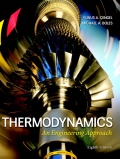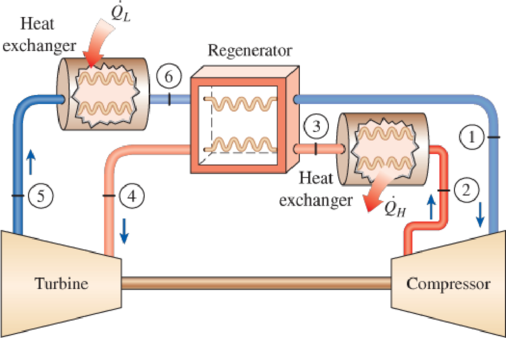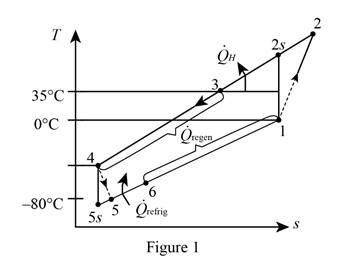
A gas refrigeration system using air as the working fluid has a pressure ratio of 5. Air enters the compressor at 0°C. The high-pressure air is cooled to 35°C by rejecting heat to the surroundings. The refrigerant leaves the turbine at −80°C and then it absorbs heat from the refrigerated space before entering the regenerator. The mass flow rate of air is 0.4 kg/s. Assuming isentropic efficiencies of 80 percent for the compressor and 85 percent for the turbine and using constant specific heats at room temperature, determine (a) the effectiveness of the regenerator, (b) the rate of heat removal from the refrigerated space, and (c) the COP of the cycle. Also, determine (d) the refrigeration load and the COP if this system operated on the simple gas refrigeration cycle. Use the same compressor inlet temperature as given, the same turbine inlet temperature as calculated, and the same compressor and turbine efficiencies.

FIGURE P11–79
(a)
The effectiveness of the regenerator.
Answer to Problem 76P
The effectiveness of the regenerator is
Explanation of Solution
Show the T-s diagram as in Figure (1).

Express the temperature at state 2s.
Here, temperature at state 1 is
Express the temperature at state 2 from the isentropic relations.
Here, isentropic efficiency is
Express temperature at state 5s.
Here, temperature at state 4 is
Express temperature at state 4.
Here, thermal efficiency is
Express the temperature at state 6 using an energy balance.
Here, mass flow rate is
Express the effectiveness of the regenerator.
Here, enthalpy at state 3, 4 and 6 is
Conclusion:
Perform unit conversion of temperature at state 1, 3, and 5 from
Refer Table A-2, “ideal gas specific heats of various common gas”, and write the properties of air.
Substitute
Substitute
Substitute
Substitute
Solve Equations (VII) and (VIII) simultaneously by online calculator to get,
Substitute
Substitute
Hence, the effectiveness of the regenerator is
(b)
The rate of heat removal from the refrigerated space.
Answer to Problem 76P
The rate of heat removal from the refrigerated space is
Explanation of Solution
Express the rate of heat removal from the refrigerated space.
Conclusion:
Substitute
Hence, the rate of heat removal from the refrigerated space is
(c)
The COP of the gas refrigeration cycle.
Answer to Problem 76P
The COP of the gas refrigeration cycle is
Explanation of Solution
Express the net work input of the compressor.
Express the net work output of the turbine.
Express the coefficient of performance of the gas refrigeration cycle.
Conclusion:
Substitute
Substitute
Substitute
Hence, the COP of the gas refrigeration cycle is
(d)
The refrigeration load and the COP of the system.
Answer to Problem 76P
The refrigeration load is
Explanation of Solution
Show the T-s diagram as in Figure (2).

Express temperature at state 4s.
Here, temperature at state 3 is
Express temperature at state 4.
Express the refrigeration load.
Express the net work input.
Express the coefficient of performance of the system.
Conclusion:
Substitute
Substitute
Substitute
Hence, the refrigeration load is
Substitute
Substitute
Hence, the coefficient of performance of the system is
Want to see more full solutions like this?
Chapter 11 Solutions
EBK THERMODYNAMICS: AN ENGINEERING APPR
- Note: Please provide a clear, step-by-step simplified handwritten working out (no explanations!), ensuring it is done without any AI involvement. I require an expert-level answer, and I will assess and rate based on the quality and accuracy of your work and refer to the provided image for more clarity. Make sure to double-check everything for correctness before submitting thanks!. Question: (In the image as provided)arrow_forwardNote: Please provide a clear, step-by-step simplified handwritten working out (no explanations!), ensuring it is done without any AI involvement. I require an expert-level answer, and I will assess and rate based on the quality and accuracy of your work and refer to the provided image for more clarity. Make sure to double-check everything for correctness before submitting thanks!. Question: The rectangular gate shown below is 3 m wide. Compute the force P needed to hold the gate in the position shown.arrow_forwardNote: Please provide a clear, step-by-step simplified handwritten working out (no explanations!), ensuring it is done without any AI involvement. I require an expert-level answer, and I will assess and rate based on the quality and accuracy of your work and refer to the provided image for more clarity. Make sure to double-check everything for correctness before submitting thanks!. Question1: If the following container is 0.6m high, 1.2m wide and half full with water, determine the pressure acting at points A, B, and C if ax=2.6ms^-2.arrow_forward
- Please read the imagearrow_forwardChapter 12 - Lecture Notes.pptx: (MAE 272-01) (SP25) DY... Scoresarrow_forwardConsider a large 6-cm-thick stainless steel plate (k = 15.1 W/m-K) in which heat is generated uniformly at a rate of 5 × 105 W/m³. Both sides of the plate are exposed to an environment at 30°C with a heat transfer coefficient of 60 W/m²K. Determine the value of the highest and lowest temperature. The highest temperature is The lowest temperature is °C. °C.arrow_forwardSketch and explain a PV Diagram and a Temperature Entropy Diagram for a 4 stroke diesel engine please, please explain into detail the difference bewteen the two and referance the a diagram. Please include a sketch or an image of each diagramarrow_forwardDraw left view of the first orthographic projectionarrow_forwardSketch and Describe a timing diagram for a 2 stroke diesel engine emphasis on the 2 stroke as my last answer explained 4 stroke please include a diagram or sketch.arrow_forwardA 4 ft 200 Ib 1000 Ib.ft C 2 ft 350 Ib - за в 2.5 ft 150 Ib 250 Ib 375 300 Ib Replace the force system acting on the frame. shown in the figure by a resultant force (magnitude and direction), and specify where its line of action intersects member (AB), measured from point (A).arrow_forwardA continuous flow calorimeter was used to obtain the calorific value of a sample of fuel and the following data collected: Mass of fuel: 2.25 kgInlet water temperature: 11 ° COutlet water temperature 60 ° CQuantity of water: 360 Liters Calorimeter efficiency: 85%Calculate the calorific value of the sample ( kJ / kg ). ive submitted this question twice and have gotten two way different answers. looking for some help thanksarrow_forward15 kg of steel ball bearings at 100 ° C is immersed in 25 kg of water at 20 ° C . Assuming no loss of heat to or from the container, calculate the final temperature of the water after equilibrium has been attained.Specific heat of steel: 0.4857 kJ / kg / ° KSpecific heat of water: 4.187 kJ / kg / ° Karrow_forwardarrow_back_iosSEE MORE QUESTIONSarrow_forward_ios
 Refrigeration and Air Conditioning Technology (Mi...Mechanical EngineeringISBN:9781305578296Author:John Tomczyk, Eugene Silberstein, Bill Whitman, Bill JohnsonPublisher:Cengage Learning
Refrigeration and Air Conditioning Technology (Mi...Mechanical EngineeringISBN:9781305578296Author:John Tomczyk, Eugene Silberstein, Bill Whitman, Bill JohnsonPublisher:Cengage Learning
